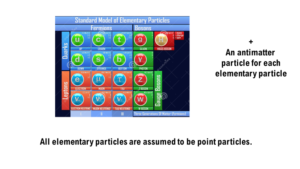Mass is considered one of the three primary physical properties of fundamental particles.
Mass is a property of matter that was first described in mathematical form by Isaac Newton in the year 1687. Mass is a property of a physical body that determines the body’s resistance to being accelerated by a force and its mutual gravitational attraction with other bodies.
With Einstein’s extension of the properties of mass with the notion of them also being relativistic towards a transformation into energy, it was necessary to redefine this physical property. That was by introducing the terms invariant mass and relativistic mass, as highlighted in this picture:
The two interpretations of what “mass” means. The first (in green) is that mass is something that does not change with speed — often called “invariant mass” or “rest mass”, it is used by particle physicists. The other, “relativistic mass”, is just energy divided by c-squared, and grows with speed. Note the two are almost identical at small velocities, and so are usually equal in daily life. ref. Matt Strassler
Even though physicists understand this concept, its logic is not entirely consistent. This thinking has a hidden assumption: that the invariant mass is not ‘energy in disguise’ but is instead a separate, identifiable physical property of matter. It is possible to imagine that within a particle with a so-called invariant mass, there is still only energy, but in a form that cannot be further distorted by us through ‘mechanical’ reduction. Therefore, it is identified as a fundamental particle, and consequently, we attribute invariant mass to such a fundamental particle as a separate physical property. It is indicative that we use its energy equivalent, eV/c², as a measure of invariant mass.
In the Standard Model, fundamental particles within the group of Fermions are assumed to have mass. 
The phenomenon of mass can be observed individually in leptons but not in quarks, which are found in particles like protons and neutrons. The proton and neutron have substantial mass, leading to the assumption that quarks also contribute to this mass.
Fermions are particles that make up matter and antimatter and play a fundamental role in the behavior of mass in atoms.
The Dutch Paradigm proposes that there are only two types of fundamental particles: the photon and the neutrino.
This animation is made available at www.thedutchparadigm.org :
An animation can be a helpful tool for teaching, as it can improve understanding of a concept. At this point in explaining the ideas in The Dutch Paradigm, it’s important to note that only two fundamental particles – the photon and the neutrino – are needed to eventually create the world as we experience it through our senses. With The Dutch Paradigm, it is therefore assumed as a first principle that only photons and neutrinos became physically observable on the occasion of the Big Bang.
In the context of the first principle, the neutrino, in its bare form, has a very small amount of ‘mass.’ This leads to another assertion: all particles demonstrating behavior characteristic of mass contain at least one neutrino within them, either in a bare form at various frequency levels or in combination with a photon.
The fact that we are currently unable to reduce ‘heavy’ particles such as the proton continues to perpetuate the underlying assumption that invariant mass is a physical reality connected to an origin.
But, it is entirely possible that we are searching for a microscopic, non-existent physical property.
Therefore, if some of the fundamental particles, as defined in the Standard Model, are actually constructs, it could be that what we indicate as invariant mass is also ‘energy in disguise.’ We refer to fermions and bosons as fundamental because we have not yet been able to break them down into smaller components. We may also never be able to do so because of currently unknown laws of nature. However, our inability to divide these particles further is insufficient to consider them the ultimate fundamental particles.

